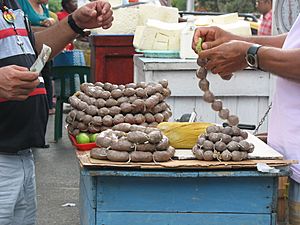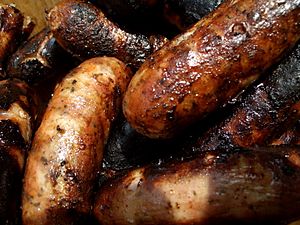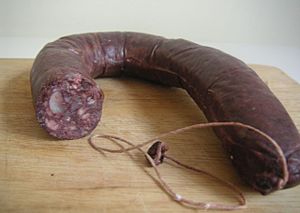Botifarra facts for kids

Botifarra (Spanish: butifarra; French: boutifarre) is a special type of sausage. It is a very important food in Catalan cuisine, which comes from the Catalonia region in Spain.
Botifarra has a long history! It is based on old recipes, possibly from the Roman sausage called botulu or lucanica. These old sausages were made from raw pork and different spices. Today, you can find similar sausages in Italy, Portugal, and Brazil, where they are called linguiça.
In Colombia, a type of botifarra called Butifarras Soledeñas is very popular, especially in a town called Soledad, Atlántico.
Contents
Different Kinds of Botifarra
There are many kinds of botifarra, each with its own special ingredients and flavors. Here are some of the most common ones:
- Raw Botifarra: This one is also known as botifarra vermella (red botifarra) or botifarra crua (raw botifarra). In some parts of Eastern Spain, it is called llonganissa. People usually cook this botifarra by grilling it or having it at a barbecue.
- Black Botifarra: Called butifarra negra or negret, this sausage gets its dark color because it has boiled pork blood mixed in with the meat.
- Catalan Botifarra: This is a large botifarra that looks a bit like cooked ham. Sometimes, it even has fancy truffles inside!
- Botifarra with Egg: Known as botifarra d'ou or butifarra de huevo, this type has egg mixed into it. It is a traditional food eaten on Fat Thursday, which is called dijous gras.
- White Botifarra: This one is called botifarra blanca or blanquet. It is made mostly from lean meat and does not have any blood in it, which is why it is white.
- Botifarra with Rice: This type, called boutifarra de arroz, has boiled rice mixed in with the meat and spices.
- Thick Botifarra Varieties: Some very thick kinds of botifarra are called Obispo (meaning "bishop") and bull. There are also bisbot negre and bull negre, which are dark versions. These are like black pudding and are made with different parts of the pig's stomach.
How People Eat Botifarra
Many types of botifarra, like white and black botifarra, do not need to be cooked before you eat them. However, they are sometimes boiled and added to traditional dishes.
For example, botifarra can be an ingredient in escudella i carn d'olla. This is a classic Catalan dish made by boiling vegetables and different kinds of meat. Botifarra is also used in the Catalan way of cooking fava beans.
One very famous Catalan dish is grilled botifarra served with white beans. This dish is called botifarra amb seques or botifarra amb mongetes in Catalan. It is a simple but delicious meal.
Botifarra Around the World
Botifarra is not just popular in Spain; it is also enjoyed in many parts of Latin America!
- Colombia: On the coast of Colombia, butifarra is a shorter, almost round sausage. People often eat it with bollo (a type of bread) made from yuca and a squeeze of lime juice.
- Argentina and Uruguay: In these countries, butifarra is a very soft, whitish sausage that is quite fatty. It is more like a smooth paste inside a casing. It is made from finely minced pork fat and meat, put into a soft sausage casing, and then boiled.
- Paraguay: Here, butifarra is a finely minced, fatty chorizo. It is often cooked as part of an asado, which is a traditional barbecue.
Butifarra is also well-known in El Salvador, and you can find it in Bolivia and Mexico.
In Tabasco, Mexico, la butifarra is a short sausage sold by street vendors. It is made from seasoned ground beef and pork, deep-fried, and usually served with tortillas.
Other Uses of the Word "Butifarra"
In Peruvian cuisine, the word butifarra is used for a specific kind of ham sandwich. The Peruvian butifarra sandwich is made with jamon del país, which is a local type of ham. So, in Peru, a "butifarra" sandwich does not actually contain the sausage called botifarra!
See also
 In Spanish: Butifarra para niños
In Spanish: Butifarra para niños




